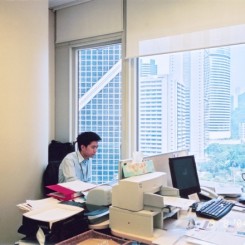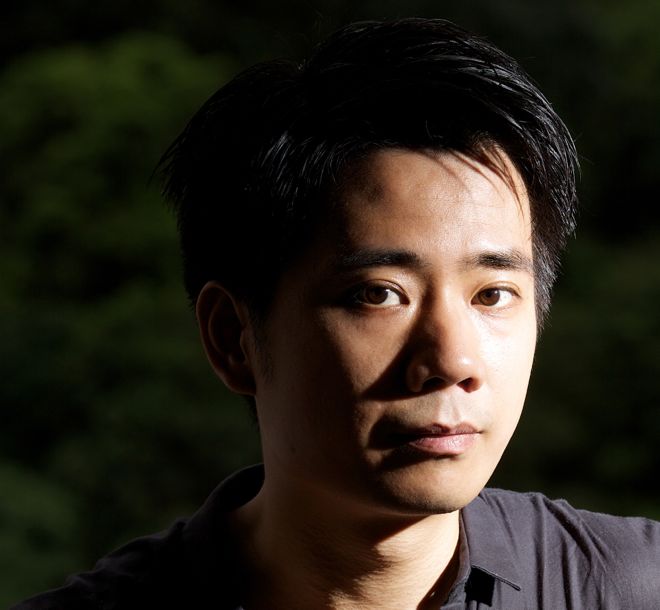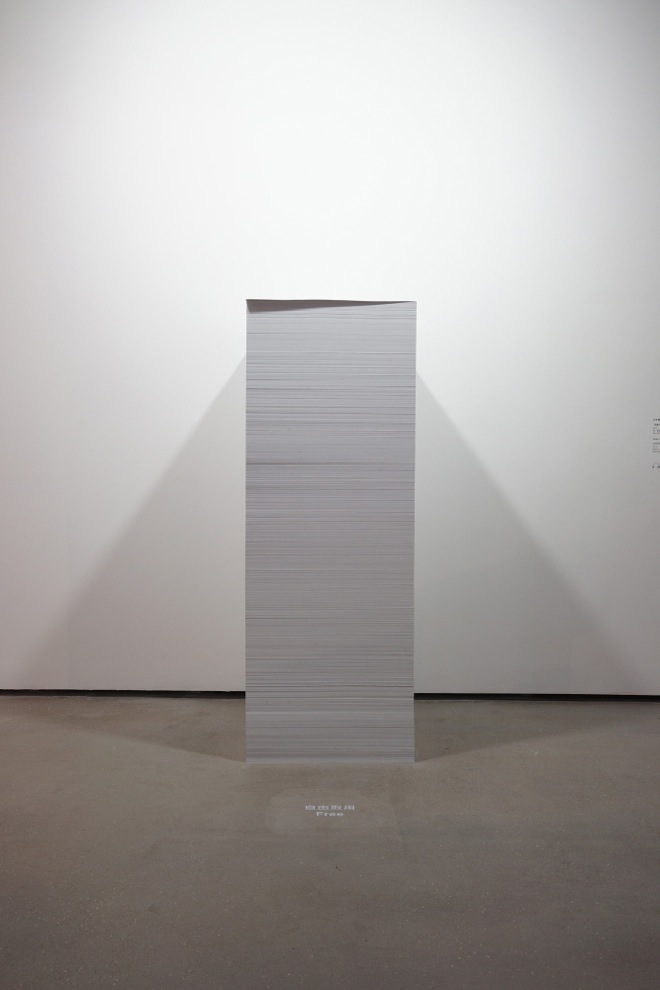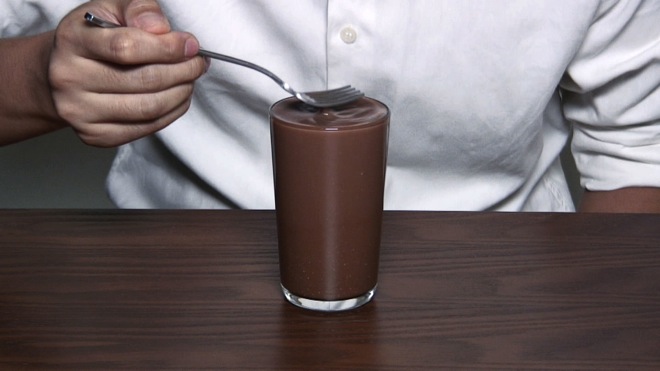At the opening of the Hong Kong International Arts and Antiques Fair in 2008, Kwan Sheung Chi took to the stage to receive the Grand Prize of the Hong Kong Arts Centre 30th Anniversary Award, not for himself—he was regarded largely as an active non-participant in these more institutional corners of the art world at that time—but on behalf his friend Chow Chun Fai, the painter, who was then working abroad. Awkwardly filming his reception of the prize with a handheld digital camera, Kwan turned the event into a short video, less than two minutes long, documenting his walk to the stage, the announcement of Chow’s prize, and his turn to face a group of photographers and applauding bystanders. It was entitled “For All the Artists who Want a Prize.” The suggestion was that Kwan didn’t really want a prize, or perhaps he wanted one about as much as he wanted a retrospective (which he organized for himself as an undergraduate art student). Five years later, he has won a rather considerable prize, the Hugo Boss Asia Art award, and in a category he most certainly would never have expected: he is now an “emerging Chinese artist.” Accompanying his nomination to the prize, Kwan is also served with a spot in the Rockbund Art Museum group exhibition celebrating a few key moments in his young career. Not, perhaps, a retrospective as grandiose as the exhibition he organized as “the King of Hong Kong New Artists” in 2002, but enough for him to chuckle over nonetheless. When one Shanghai blog declared that “Kwan Sheung Chi has almost no chance of winning the cash,” the artist immediately posted the quote on Facebook with no small amount of glee.
More so than whatever a prize like this might mean to the artist, however, is the question of what his success in Shanghai indicates about the Chinese art world at the moment—and, by transference, what role Hong Kong is playing in relation to this system. Whereas artists working in Hong Kong were once fond of saying that their work was intentionally small in scale and craft in nature in order to either subvert or differentiate itself from the massive and manufactured stereotype of work produced in Beijing, and that their interest in the prosaic everyday functioned as a counterpoint to the focus on society, politics, urbanism, and collective memory evident on the mainland, the tables have turned. Collective memory has overtaken personal experience in Hong Kong’s art schools, and social practice, which has always been a pedagogical force, has displaced a good deal of the former interest in craft and materiality, dovetailing with an incrementally shifting lens on emerging art from mainland China.
This transition was also evident in the May 2013 issue of the Beijing-published magazine LEAP, which placed a heavy editorial focus on Hong Kong to coincide with the debut of Art Basel in Hong Kong. (Pursuant to this discussion, it should be noted that this thematic focus puts the city on a categorical plane shared with performance art, science fiction, and the Mayan apocalypse.) That issue, “Hong Kong, Mon Amour,” purported to take on the hard-hitting age-old question: “Is today’s Hong Kong still a cultural desert?” Although a range of perspectives were included (including, in the interests of disclosure, my own), the editorial emphasis was firmly on activist artistic practice, party politics, and the relationship between art, the state, and the people. In a beguiling historical accident, the not-as-free-as-it-thinks market of Hong Kong has come to provide public housing, subsidized medical care, grants for artistic production, and a public museum culture on a level long forgotten within the annals of “socialism with Chinese characteristics.” Like the “curated” section of an art fair, Hong Kong has come to represent the potential political consciousness of art attached to the broader market for Chinese culture even as the Hong Kong art scene itself remains far more mercantilist in outlook in comparison with the more reflective exhibition culture in Beijing and Shanghai—although this is a question for another time and place.
Kwan Sheung Chi is attractive as an “emerging Chinese artist” for a number of reasons, chief among them the fact that a practice like his could never exist in China. Even the Rockbund exhibition, which includes the flaccid provocation of “Untitled (White)” (2013), a stack of paper cut to the dimensions of 89 x 64 cm in reference to the end date of the 1989 protests in China, a whole set of works were blocked from making the trip, in light of which it is almost a surprise that Kwan agreed to take part at all. One of the pieces in the exhibition, “Doing It with Chi…Making an Exit Bag” (2009), is a short video in which the artist, standing in his kitchen studio, teaches the viewer how to make a simple device for peaceful, unassisted suicide. In another work from the same series, “Doing It with Mrs. Kwan…Making Pepper Spray” (2012), Kwan’s wife and frequent collaborator, the artist Wong Wai Yin, provides similar instructions for a more aggressive weapon—or, depending on cultural context, an important option for self-defence.

Kwan Sheung Chi, “Doing it with Chi…Making an Exit Bag”, single-channel video; HDV, color, stereo sound, 3 mins 44s, 2009
關尚智,《跟阿智一起做…製作往生袋》,單頻錄像;HDV,彩色,立體聲,三分四十四秒,2009

Kwan Sheung Chi, “Doing It with Mrs Kwan…Making Pepper Spray”,single-channel video; HD, color, mono sound, 5 mins 16s, 2012
關尚智,《跟關太一起做… 製作胡椒噴霧》,單頻錄像;高清數碼錄像,彩色,單聲道,五分十六秒,2012
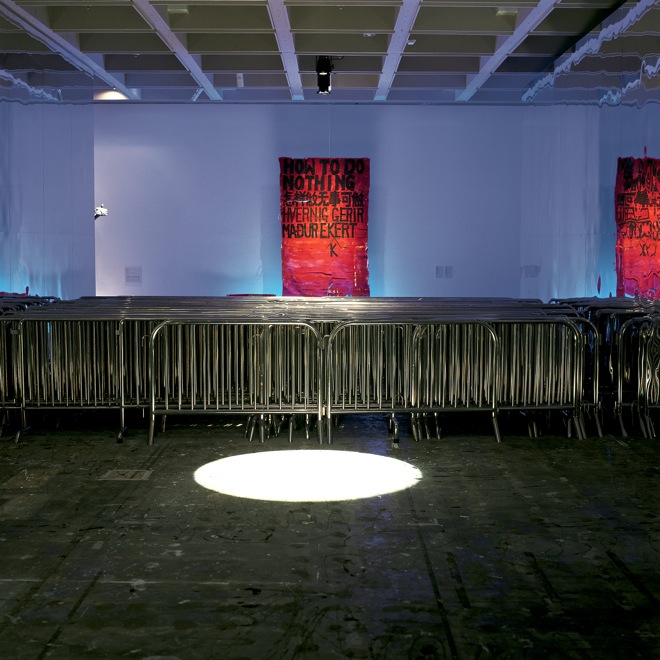
Kwan Sheung Chi, “Ask the Hong Kong Museum of Art to borrow ‘Iron Horse’ barriers: I want to collect all of the ‘Iron Horse’ barriers in Hong Kong here”,100 “Iron Horse” barriers, plexiglass mirrors, dimensions variable, 2008
關尚智,《請香港藝術館幫忙借「鐵馬」圍欄:我想收藏香港所有「鐵馬圍欄在這兒》,100隻「鐵馬」圍欄、塑膠玻璃鏡,尺寸可变,2008
But it is an earlier work, neither included in nor excluded from the Rockbund exhibition, that proves just how foreign Kwan Sheung Chi’s practice might appear to a Chinese audience: in “Ask the Hong Kong Museum of Art to Borrow “Iron Horse” Barriers: I Want to Collect All of the “Iron Horse” Barriers in Hong Kong Here” (2008), the artist, invited to pay tribute to Antonio Mak, the Hong Kong sculptor of horses, tigers, and humans, convinced a government museum to requisition the metal fences used by police to contain protest routes. While the symbolic gesture of taking away the tools of the police should be proof enough, this willingness to engage directly with the government, both amiably and critically, would be unheard of outside of the political system of Hong Kong.
As an artistic gesture, this notion of engagement might be traced, at least in part, to Kwan Sheung Chi’s training at the Chinese University of Hong Kong, where he studied alongside a celebrated group of artists including Chow Chun Fai, Lam Tung-Pang, Lee Kit, and Pak Sheung Chuen. The fine arts department of the school belonged, until a recent institutional restructuring, to New Asia College, the academy founded by philosopher Qian Mu in 1950 in response to changing intellectual conditions on the mainland. While the myth of an unbroken trend of Confucian ethical education might be overly facile, the school has indeed maintained a tradition of critical pedagogy tied to the social responsibility of the intellectual and the meditative power of modernist studio practice. This ultimately comes to mean a range of different things, but the “New Asian Spirit,” as it is called, is evident in the work of many of these artists: Chow Chun Fai, though he insisted on keeping politics out of his work until recently, ran for a seat in the Hong Kong Legislative Council, and has since taken to executing large-format paintings of key moments in television reportage; Lee Kit does not allow political messages into individual works, but maintains a strong social consciousness, and his practice stands, in totality, as a reminder of what a more contemplative, less market-manic Hong Kong lifestyle might be like.
Kwan Sheung Chi, perhaps more so than any of his peers, offers a living reflection of what the trajectory of the New Asian Spirit might look like in the 21st century greater Chinese art world, and there is a certain ironic symmetry to seeing this position earn recognition back in the city Qian Mu fled some six decades ago. Of course, Kwan is no Confucian traditionalist, and the philosophical underpinnings of his practice (and the New Asia College as a whole) have evolved to embrace the currents of pluralist, democratic modernity while retaining the fundamental unit of the intellectual studio, a socially aware if somewhat removed status. Kwan’s work, in some cases recalling Lee Kit’s, plays up the tension between meditation and intervention: when he was still working part-time for a commercial art dealer specializing in leasing conservative, abstract artwork to corporate offices, he staged a series of guerrilla projects in the office when his boss was out of town, an ethic that culminated most dramatically in “A Shirt I Wore to Work” (2004). For this performance and artifact, he painstakingly wrote the phrase “I am artist” thousands of times on a hand-sewn shirt that he then, naturally, wore to work, as if willing himself into being.
What is fascinating about Kwan Sheung Chi’s recent recognition in the Hugo Boss Asia Art exhibition is that the meditative and participatory approach to socially aware practice he shares in common with a good proportion of emerging Hong Kong art, especially that coming out of the New Asia College, is that it is so bluntly assertive in its political stance, particularly in comparison with the more contemporary theoretical approaches espoused by younger artists working in mainland China. To borrow a phrase Jiang Zemin infamously used to reprimand journalists from the city, this upstart Hong Kong generation is “too young, too simple, sometimes naïve.” This is, again, precisely why a certain side of Hong Kong art is so attractive a proposition for mainland observers: it functions on a level of direct simplicity that would be neither practicable nor useful in Beijing or Shanghai. For better or worse, the ongoing struggles over democratic elections in Hong Kong circulate through a very old-fashioned mode of protest and appeasement: demonstrations often involve marches, sing-along rallies, burning effigies, and candlelight vigils. While the goals of this movement are clear, valid, and probably attainable, its culture has lost sight of the larger formulations of politics, particularly within the regional system of which Hong Kong is only one very small part. Ultimately, without understanding the channels of power in media and symbolic politics as they relate to mainland China, the democracy movement in Hong Kong can only belong to an isolated dialectic of its own fabrication.
As an artist, Kwan Sheung Chi is more than a simple advocate for democracy in Hong Kong, but his work does often put forward a principled, activist stance. Aside from the rather boring symbolism of “Untitled (White),” other recent works have turned more towards capitalism and the connections between finance and politics, a direction that reflects the artist’s roots in the criticism of Hong Kong real estate development corporations and their aesthetics. For one of the first exhibitions commissioned by Hong Kong’s M+ Museum of Visual Culture, Kwan Sheung Chi and Wong Wai Yin produced a complex work entitled “To Defend the Core Values is the Core of the Core Values” (2012). At the time, there was a broad conversation in the Hong Kong media about what the “core values” of Hong Kong culture might be, and who might have the rights to mobilize them—this quickly transformed into very concrete questions about whether or not British values belonged to the “core” of Hong Kong, if democracy could be considered a core value, and a wide range of other issues. Kwan and Wong used their production budget to cast a gold coin reading “Hong Kong Core Values” (not coincidentally, in light of recent work, weighing 6.4 oz), and promised to raffle it off to whoever could best define these illusive core values. Ultimately, they chose Leung Kwok-hung, the self-identified Trotskyist legislator popularly known as “Longhair” (“Cheung Mo”) and infamous for throwing bananas to disrupt the less-than-democratic procedures of the Legislative Council. Accepting the coin as a donation, Leung offers a spontaneous discourse on the “core values” in a video that documents the entirety of the project.
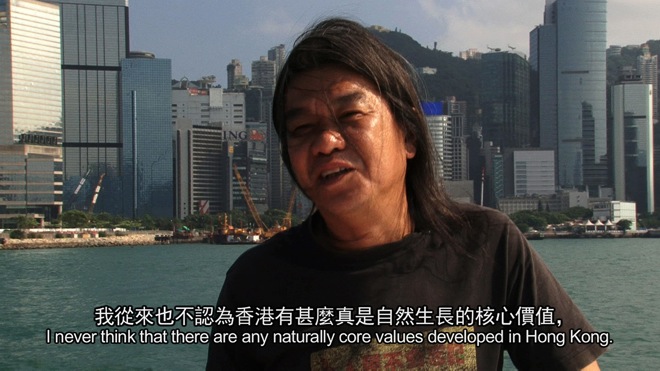
Kwan Sheung Chi and Wong Wai Yin, “To Defend the Core Values is the Core of the Core Values”, installation with pure gold coin; events; videos, 2012
關尚智及黃慧妍,《捍衛核心價值是最核心的核心價值》,裝置,包括純金金幣;活動;錄像,2012

Kwan Sheung Chi, “1000″, one-thousand-dollar Hong Kong banknote, surface patterns erased with a rubber eraser, 8.1 x 16.7 cm, 2012
關尚智,《1000》,一千元香港鈔票,表面圖案以橡皮擦擦除, 8.1 x 16.7 cm, 2012
If the ethical position here is an activist one (money from a publicly funded museum is transferred to an opposition member of the legislature), the bundle of techniques deployed has learned more from the legacies of conceptual art. Similarly, in “1000” (2012), Kwan took a simple rubber eraser to the surface of a HK$1000 bill, successfully erasing virtually everything but the denomination and a bit of the image in the background. Kwan Sheung Chi is fond of a certain kind of art that might be easily described through a list of instructions but requires a specific social position to carry out: any one could execute this work, as long as he or she is willing to part with a significant amount of money. Indeed, the same description might apply to “To Defend the Core Values.” This opens up another angle from which Kwan’s work might look particularly attractive against the background of emerging Chinese art. Whereas no small amount of lip service is paid to “conceptual art” (gainian yishu) among mainland artists, more often than not what is really being described is a form of conceptually informed installation work—work that has an idea attached to or embedded within it, but ultimately requires an architectural manifestation to frame that idea. Kwan, by contrast, truly digs into and engages with what it means to take concept as a material for process, picking up on the techniques of Kosuth, Baldessari, Haacke, and Weiner but, like so many artists working on the periphery, turning the conceptual into a practice grounded in culture and place.
Kwan’s practice marks an interesting synthesis of a historically rooted conceptual approach with notions of craft and studio work drawn from the New Asian Spirit. He lives outside the city in a small village, replicating to some degree the solitary retreat of the scholar, and produced many of his best-known works in his kitchen, creating unavoidable parallels between recipe and conceptual instructions, cooking and production. Here the notion of domesticity and intimacy is an important one—aside from working with his wife, Kwan has also collaborated with his mother, asking her to produce technical drawings of a short table that he then built, exhibiting the documentation of the project as “Teapoy” (2005). But Kwan’s material, when it comes to craft, is indubitably video, and it seems likely that his performative documentations will be remembered long after some of his weaker one-off interventions and installations. There is the instructional Doing It series, noted previously. Then there are the durational performances, each tied to a simple conceptual action: “Break Up a Short Piece of Thread” (2009) films two hands pulling at an inch-long piece of thread for more than six minutes, occasionally succeeding and proceeding to pull at ever smaller segments, while “Drinking a Glass of Hot Chocolate with a Fork” (2011) depicts a figure doing just that over the course of a half-hour. Here, too, he succeeds, and it seems he will always find a way to do so. In a twist on this effect, “One Million (RMB)” (2013), the continuation of a series employing different currencies, finds Kwan flipping through a short stack of bills, counting until he reaches a million. Here, this is accomplished through editing, as the video repeats a loop of several seconds over the course of an hour and a half. Unlike in the case of “To Defend the Core Values” or “1000,” in which currency is an object of critique or a tool of activism, in this case—a work that might otherwise read as a celebration of wealth—the money is never really there.
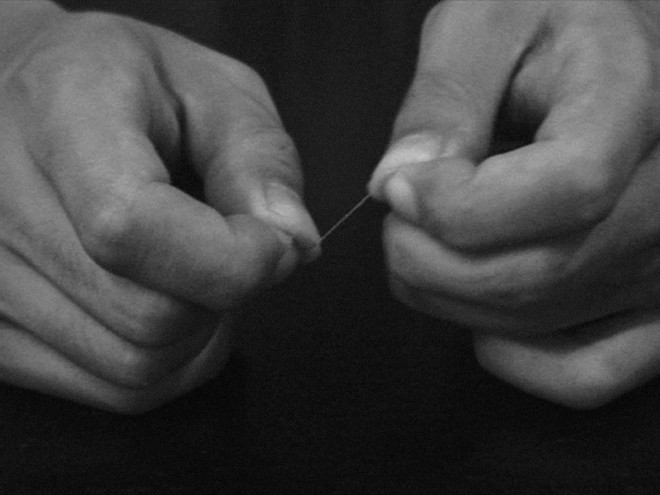
Kwan Sheung Chi, “Break Up a Piece of Short Thread”, single-channel video; DV PAL, B&W, Silent, 43 mins 43s, 2009
關尚智,《撕斷一段短線》,單頻錄像;數碼錄像PAL格式,黑白,無聲,四十三分四十三秒,2009
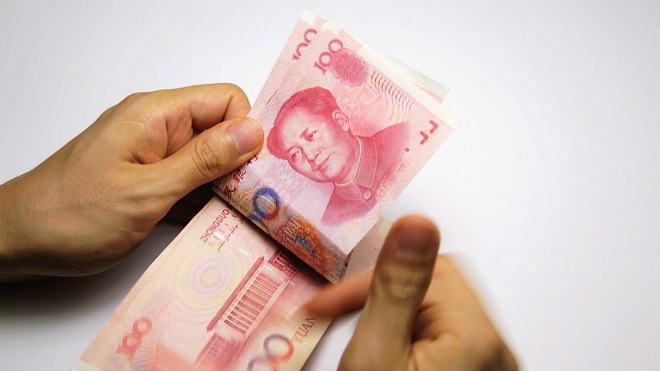
Kwan Sheung Chi, “ONE MILLION (Renminbi)”, single-channel video; HD, color, mono sound, 1hour 20 mins 24s, 2013
關尚智,《一百萬 (人民幣)》,單頻錄像;高清,彩色,單聲道,一小时二十分二十四秒,2013
This leads to a final strand of Kwan Sheung Chi’s practice, one that contains work less important than his performative videos or activist interventions but nevertheless indicates a clear path for how his work might function in the broader social context of the international art world. While collaborations with Longhair and performances in the offices of art dealers or at the openings of art fairs might remain legible only within the microscopic context of the Hong Kong art scene, it is the more general or categorical gestures that contain potential for circulation further afield, as his reception at the Hugo Boss Asia Art exhibition at Rockbund has indicated. (It should be noted that the Hugo Boss award is awarded on the strengths of an artist’s entire output, not exclusively on his or her presentation at the Rockbund Museum.) This pattern mirrors how Lee Kit’s work, too, has shifted as it is visible more and more outside of Hong Kong: over the past decade, his practice has transitioned from events, either public or private, to environments, producing similar effects and affect but involving viewers and participants in very different ways. Similarly, Kwan’s work in Shanghai is positioned as interventions for the viewer, not for the artist; whereas his projects in Hong Kong are often intended to improve the political, social, or artistic conditions of his own world, here he provides instructions and suggestions for how similar projects might be executed in Shanghai.
By working in a less personal and less interventionist way, Kwan Sheung Chi suggests that the viewer turn to a different set of works he has created over the course of his career: queer objects of near talismanic power that are transformed through a conceptual lens and allowed to float freely in an open universe of signs and patterns. In “A Dead Mosquito” (2008), Kwan pastes his own blood and hair to a white wall in the shape of a smashed mosquito carcass, subtly suggesting a link between the blood, sweat, and tears of the artist and the gadfly—or at least a peskier version. For “Apple Core” (2008), he crushes a cardboard juicebox into the shape of an eaten and discarded apple, appearing white at the inner section and red and green on the ends, with a plastic straw even playing the role of the stem. In “Correction Pen Corrected with Its Own Content” (2012), a tube of correction fluid is dipped in correction fluid, gesturing towards Robert Morris’s “Box with the Sound of Its Own Making” (1961)—the work that spawned an entire genre of imitations—while shifting it towards the dynamics of aesthetic and social correctness. In “Lilies” (2012), Kwan collects 12 different iterations of plastic lilies, celebrating manufactured “uniqueness” and pointing to an industry that played a surprisingly central role in post-war Hong Kong, launching the career of tycoon Li Ka-shing, among others.
These works are not, clearly, the best reflection of the “core values” of Kwan Sheung Chi’s artistic practice, but they suggest a way of working that may become more common as his exhibitions and projects spread beyond the geopolitical purview of Hong Kong. His approach to concept remains obtuse rather than poignant, and it is this naïve simplicity—feigned or otherwise—that defines how his work is positioned and received, particularly in relation to emerging art from China. In Shanghai, the general sense of his work is that of a blunt object colliding with an immovable mass, much like his flagship installation in the exhibition: “Water Barrier (Maotai:Water, 1:999)” (2013), a pair of traffic barriers of the plastic, water-filled sort that have come to replace the iron fences of “Ask the Hong Kong Museum of Art” at both major protests and more prosaic events, like road construction. True to form, Kwan himself spent a bit of time trying to knock down the barriers, here laced with the alcohol of choice for state functions in Mainland China and, increasingly, Hong Kong. But in keeping with the fact that this particular intervention might, hypothetically, have more universal consequences outside of his own life in Hong Kong, he also encourages his audience to do the same, framing the barriers with a sign that reads like a declaration of his particular brand of social consciousness: “Please Tear Down this Wall. Warm Reminder: Beware of People Behind.”
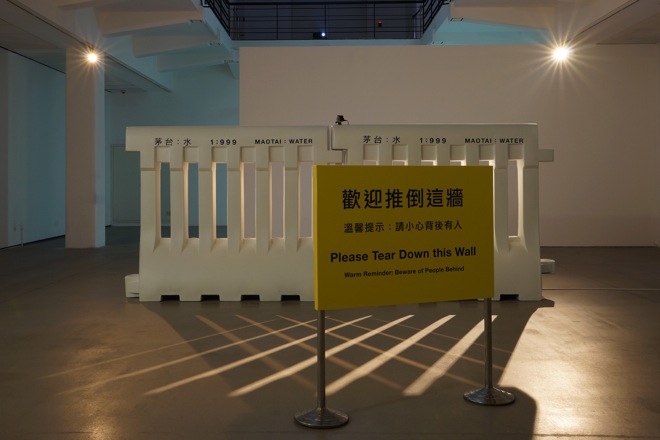
Kwan Sheung Chi, “Water Barrier (Maotai : Water, 1:999)”, installation, 2013
關尚智,《水馬路障 (茅台:水,一比九百九十九)》,裝置,2013



